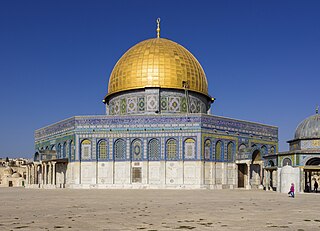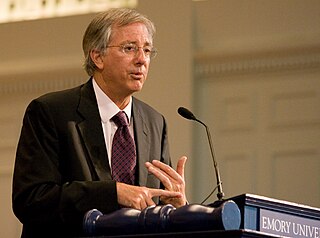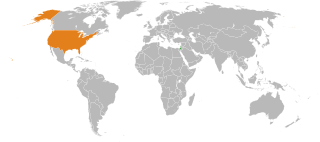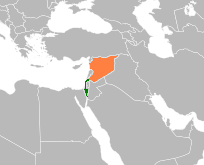
United Nations Security Council Resolution 242 (S/RES/242) was adopted unanimously by the UN Security Council on November 22, 1967, in the aftermath of the Six-Day War. It was adopted under Chapter VI of the UN Charter. The resolution was sponsored by British ambassador Lord Caradon and was one of five drafts under consideration.

The history of the State of Palestine describes the creation and evolution of the State of Palestine in the West Bank and Gaza Strip. During the Mandatory period, numerous plans of partition of Palestine were proposed but without the agreement of all parties. In 1947, the United Nations Partition Plan for Palestine was voted for. The leaders of the Jewish Agency for Palestine accepted parts of the plan, while Arab leaders refused it. This triggered the 1947–1949 Palestine war and led, in 1948, to the establishment of the state of Israel on a part of Mandate Palestine as the Mandate came to an end.

The Camp David Accords were a pair of political agreements signed by Egyptian President Anwar Sadat and Israeli Prime Minister Menachem Begin on 17 September 1978, following twelve days of secret negotiations at Camp David, the country retreat of the President of the United States in Maryland. The two framework agreements were signed at the White House and were witnessed by President Jimmy Carter. The second of these frameworks led directly to the 1979 Egypt–Israel peace treaty. Due to the agreement, Sadat and Begin received the shared 1978 Nobel Peace Prize. The first framework, which dealt with the Palestinian territories, was written without participation of the Palestinians and was condemned by the United Nations.

The Geneva Initiative, also known as the Geneva Accord, is a draft Permanent Status Agreement to end the Israeli–Palestinian conflict, based on previous official negotiations, international resolutions, the Quartet Roadmap, the Clinton Parameters, and the Arab Peace Initiative. The document was finished on 12 October 2003.

Intermittent discussions are held by various parties and proposals put forward in an attempt to resolve the ongoing Israeli–Palestinian conflict through a peace process. Since the 1970s, there has been a parallel effort made to find terms upon which peace can be agreed to in both the Arab–Israeli conflict and in the Palestinian–Israeli conflict. Notably the Camp David Accords between Egypt and Israel, which included discussions on plans for "Palestinian autonomy", but did not include any Palestinian representatives. The autonomy plan would not be implemented, but its stipulations would to a large extent be represented in the Oslo Accords.

Dennis B. Ross is an American diplomat and author. He served as the Director of Policy Planning in the State Department under President George H. W. Bush, the special Middle East coordinator under President Bill Clinton, and was a special adviser for the Persian Gulf and Southwest Asia to former Secretary of State Hillary Clinton. Ross is currently a fellow at The Washington Institute for Near East Policy, a pro-Israel think tank, and co-chairs the Jewish People Policy Institute's board of directors.

The Taba Summit were talks between Israel and the Palestinian Authority, held from 21 to 27 January 2001 at Taba, in the Sinai. The talks took place during a political transition period – Israeli Prime Minister Ehud Barak had resigned six weeks previously on 9 December 2000, and elections were due on 6 February 2001, and the inauguration of President George W. Bush had taken place just one day prior, on 20 January 2001.

Since the 1960s, the United States has been a strong supporter of Israel. It has played a key role in the promotion of good relations between Israel and its neighbouring Arab states—notably Jordan, Lebanon, Egypt—while holding off hostility from countries such as Syria and Iran. Relations with Israel are an important factor in the U.S. government's overall foreign policy in the Middle East, and the U.S. Congress has placed considerable importance on the maintenance of a supportive relationship.
The Geneva Conference of 1973 was an attempt to negotiate a solution to the Arab–Israeli conflict as envisioned in United Nations Security Council Resolution 338 following the called-for cease-fire to end the Yom Kippur War. After considerable "shuttle diplomacy" negotiations by Henry Kissinger, the conference opened on 21 December 1973 under the auspices of the United Nations Secretary General, with the United States and the USSR as co-chairmen. The foreign ministers of Egypt, Jordan and Israel were in attendance. The table with Syria's nameplate remained unoccupied, although Syria had indicated possible future participation. Each foreign minister spoke, mainly directed to their domestic audiences rather than to each other. Kissinger articulated his step-by-step strategy and stated that the goal of the conference was peace; the immediate need was to strengthen the cease-fire by accomplishing a disengagement of forces as the "essential first step" toward implementation of UN 242. The meeting was then adjourned.
The Arab–Israeli conflict began in the 20th century, evolving from earlier Intercommunal violence in Mandatory Palestine. The conflict became a major international issue with the birth of Israel in 1948. The Arab–Israeli conflict has resulted in at least five major wars and a number of minor conflicts. It has also been the source of two major Palestinian uprisings (intifadas).

The Arab Peace Initiative, also known as the Saudi Initiative, is a 10 sentence proposal for an end to the Arab–Israeli conflict that was endorsed by the Arab League in 2002 at the Beirut Summit and re-endorsed at the 2007 and at the 2017 Arab League summits. The initiative offers normalisation of relations by the Arab world with Israel, in return for a full withdrawal by Israel from the occupied territories, with the possibility of comparable and mutual agreed minor swaps of the land between Israel and Palestine, a "just settlement" of the Palestinian refugee problem based on UN Resolution 194, and the establishment of a Palestinian state with East Jerusalem as its capital. A Palestinian attack called the Passover massacre took place on 27 March 2002, the day before the Initiative was published, which initially overshadowed it.

The Missing Peace: The Inside Story of the Fight for Middle East Peace (ISBN 0-374-19973-6) is a 2004 non-fiction book by Dennis Ross on the history of and his participation in the Israeli–Palestinian peace process and the Arab–Israeli peace process. Ross, an American diplomat, was the Director of Policy Planning in the State Department under President George H. W. Bush and the special Middle East coordinator under President Bill Clinton.

Israel–Syria relations refer to the bilateral ties between the State of Israel and the Syrian Arab Republic. The two countries have been locked in a perpetual war since the establishment of Israel in 1948, with their most significant and direct armed engagements being in the First Arab–Israeli War in 1948–1949, the Third Arab–Israeli War in 1967, and the Fourth Arab–Israeli War in 1973. Additionally, Israeli and Syrian forces also saw relatively extensive combat against each other during the Lebanese Civil War, the 1982 Lebanon War, as well as the War of Attrition. Both states have at times signed and held armistice agreements, although all efforts to achieve complete peace have been without success. Syria has never recognized Israel as a legitimate state and does not accept Israeli passports as legally valid for entry into Syrian territory; Israel likewise regards Syria as a hostile state and generally prohibits its citizens from travelling there, with some exceptions and special accommodations being made by both countries for Druze people residing in Syria and the Golan Heights. Israel and Syria have never established formal diplomatic relations since the inception of both countries in the mid-20th century.

The bilateral relations between the State of Palestine and Russia have a complex history, deeply interwoven with Russian and Soviet relations with the Israeli enterprise, Palestinian nationalism, and Third World national liberation movements. Between 1956 and 1990, Soviet-Palestinian relations were part of the then ongoing Soviet-American confrontation.

The Oslo Accords are a pair of interim agreements between Israel and the Palestine Liberation Organization (PLO): the Oslo I Accord, signed in Washington, D.C., in 1993; and the Oslo II Accord, signed in Taba, Egypt, in 1995. They marked the start of the Oslo process, a peace process aimed at achieving a peace treaty based on Resolution 242 and Resolution 338 of the United Nations Security Council. The Oslo process began after secret negotiations in Oslo, Norway, resulting in both the recognition of Israel by the PLO and the recognition by Israel of the PLO as the representative of the Palestinian people and as a partner in bilateral negotiations.

The Annapolis Conference was a Middle East peace conference held on 27 November 2007, at the United States Naval Academy in Annapolis, Maryland, United States. The conference aimed to revive the Israeli–Palestinian peace process and implement the "Roadmap for peace". The conference ended with the issuing of a joint statement from all parties. After the Annapolis Conference, the negotiations were continued. Both Mahmoud Abbas and Ehud Olmert presented each other with competing peace proposals. Ultimately no agreement was reached.

The Madrid Conference of 1991 was a peace conference, held from 30 October to 1 November 1991 in Madrid, hosted by Spain and co-sponsored by the United States and the Soviet Union. It was an attempt by the international community to revive the Israeli–Palestinian peace process through negotiations, involving Israel and the Palestinians as well as Arab countries, including Jordan, Lebanon and Syria.
George H. W. Bush, whose term as president lasted from 1989 until 1993, had extensive experience with US foreign policy. Unlike his predecessor, Ronald Reagan, he downplayed vision and emphasized caution and careful management. He had quietly disagreed with many of Reagan's foreign policy decisions and tried to build his own policies. His main foreign policy advisors were Secretaries of State James Baker, a longtime friend, and National Security Advisor Brent Scowcroft. Key geopolitical events that occurred during Bush's presidency were:

The Helsinki Summit was a private, bilateral meeting between American President George H. W. Bush and Soviet President Mikhail Gorbachev that took place in Helsinki, Finland on September 9, 1990. Due to the vested interests of both the Soviet Union and the United States in the Gulf Crisis' resolution, August 1990 Iraqi invasion of Kuwait was the primary topic of discussion for the leaders during the Helsinki Summit. The concerted efforts at easing American-Soviet tensions in the aftermath of the Cold War was another prominent topic, among other notable current events. At the summit's conclusion, Presidents Bush and Gorbachev produced a document of joint statements that illuminated the areas in which the leaders had committed to aligning their foreign policy goals. The summit was followed by a press conference wherein members of the media questioned Presidents Bush and Gorbachev about the content of their meeting and the justifications for their joint statements.

The Washington Summit of 1990, also known as the "Two Plus Four" talks, was an international summit in the history of the Cold War in which the United States and Germany gained the Soviet Union's support for the reunification of Germany by agreeing that NATO needed to be reformed. As part of this effort, US President George H. W. Bush called for a NATO summit to reform the organization and demonstrate NATO's willingness to present a different approach to the Soviet Union. As part of his efforts to improve relations between the United States and the Soviet Union, Bush proposed a bilateral summit in Washington to Soviet Union President Mikhail Gorbachev, in addition to the NATO summit. Gorbachev agreed to the proposal, which resulted in the Washington Summit of 1990.